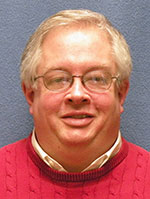Reflection / Sean Gallagher
COVID-19 pandemic can help Catholics enter into their common priesthood
 This weekend, many Catholics across central and southern Indiana will worship at Sunday Mass for the first time in two months.
This weekend, many Catholics across central and southern Indiana will worship at Sunday Mass for the first time in two months.
Public celebration of the Mass and the other sacraments was suspended on
March 17 across the state as part of a broader social effort to slow the spread of the coronavirus.
But the liturgies that will be celebrated this weekend will be different in many ways than those we experienced before March 17.
Because the coronavirus remains a significant threat, seating capacity in parish churches will be reduced. And people 65 or older or who have complicating medical conditions are advised to remain at home. Because of these and other factors, Archbishop Charles C. Thompson has extended the dispensation from the obligation to participate in Sunday Mass until Aug. 15.
So, although Catholic churches are reopening and the sacraments are starting to be celebrated again, many of our brothers in sisters in faith will not be able to gather for worship before the Lord’s altar.
Perhaps the challenges in our lives of faith that all Catholics of central and southern Indiana have faced over the past two months and those still being borne by many can lead us to enter more fully into what I feel is an underappreciated aspect of our faith: the Church’s teaching on the common priesthood of all the faithful.
When the Son of God came among us and took on our human nature, his mission involved a threefold ministry as priest, prophet and king.
Each person who is baptized into Christ receives a share in each of those ministries. Yes, there is a priesthood that is distinct from the ordained priesthood that we know and appreciate so well.
St. Peter described all the faithful, though, as “a holy priesthood” who offers “spiritual sacrifices acceptable to God through Jesus Christ” (1 Pt 2:4). St. John, in the Book of Revelation, said that Christ has made his followers “into a kingdom, priests for his God and Father” (Rev 1:6). These New Testament references to God’s people as priests echoes similar thoughts expressed in the Old Testament in Exodus, Isaiah and Ezekiel.
We believe that ordained priests in the Church re-present anew at every Mass the one perfect sacrifice that Christ made in his death on the cross.
We lay Catholics who worship at Mass are not just mere spectators at this wondrous event. We are invited to join to the sacrifice of the bread and wine on the altar that become the body and blood of Christ through the many sacrifices we make in our everyday lives.
While the celebration of a Sunday Mass in a formal way may last about an hour, lay Catholics, as part of the common priesthood of the Church, are empowered by God’s grace to extend its effects throughout the week. And we also prepare for the next Mass by, in
St. Paul’s words, offering our “bodies as a living sacrifice, holy and pleasing to God” (Rom 12:1) in the many small and sometimes large sacrifices we make in our daily lives.
The Church’s ordained priesthood and common priesthood, then, are closely interrelated and are called to support each other.
In the two months that the public celebration of the Mass was suspended, it still continued as priests offered the Eucharist in their parish churches, often livestreamed online.
Even though lay Catholics could not be present physically at those liturgies, God’s grace allowed us to take part in the sacrifice of the Mass in a real if spiritual way through our common priesthood.
Wherever the Mass is celebrated, we Catholics here in Indiana and around the world are joined together in Christ’s mystical body and take part in his perfect sacrifice on Calvary. And then we extend its power, grace and mercy to the ends of the Earth, all the way to our own little corner of it through living out our common priesthood.
This is a tremendous mission to enter more fully into as we are blessed to take part once again in the Church’s public worship.
(Sean Gallagher is a reporter for The Criterion.) †
 This weekend, many Catholics across central and southern Indiana will worship at Sunday Mass for the first time in two months.
This weekend, many Catholics across central and southern Indiana will worship at Sunday Mass for the first time in two months.